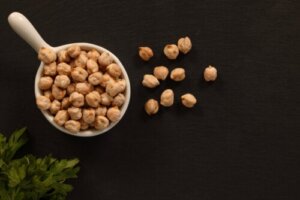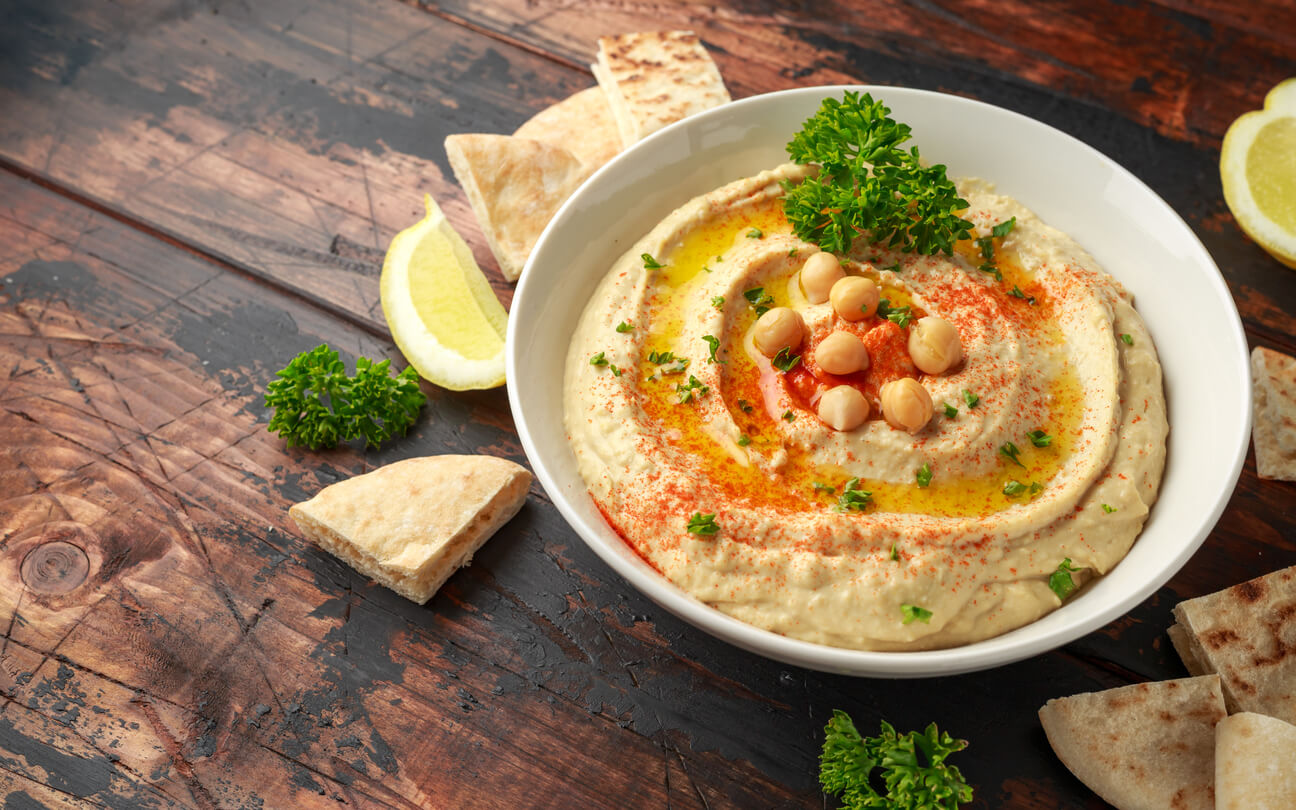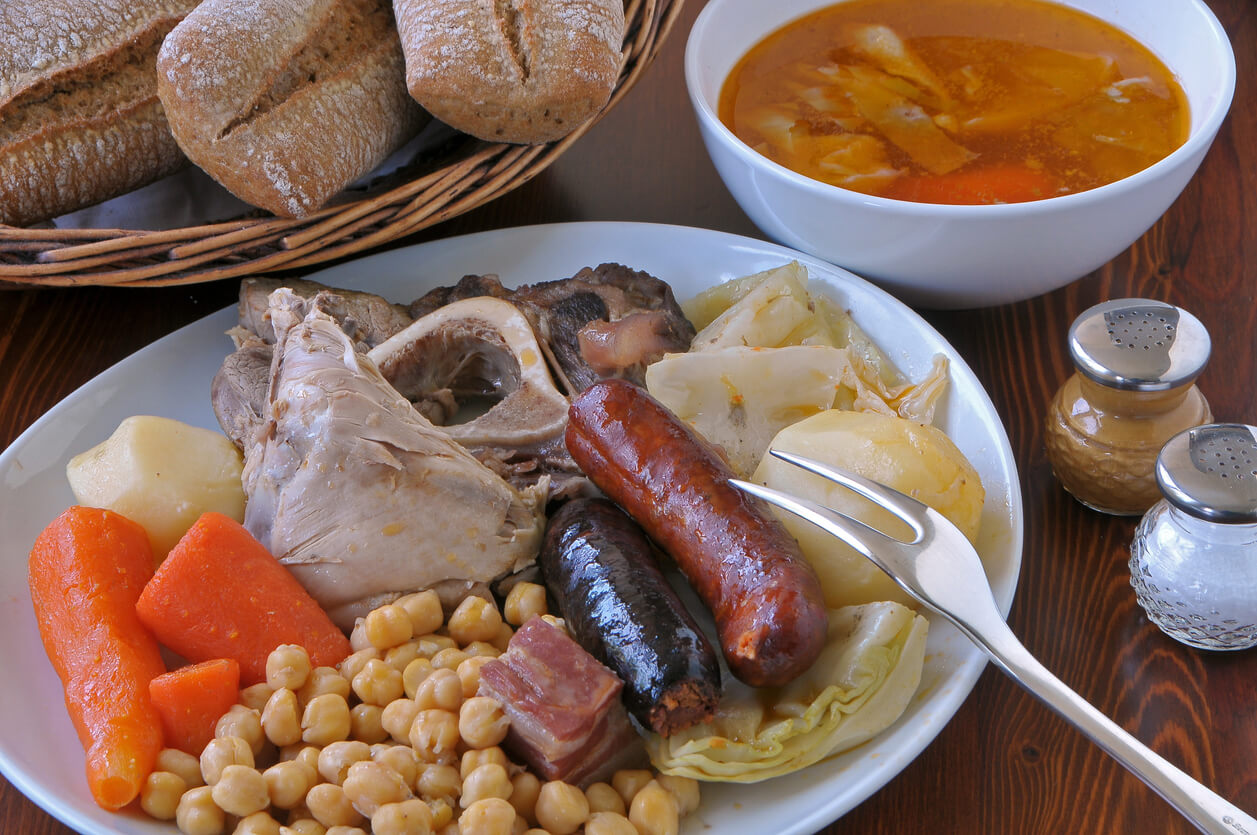2 Delicious Recipes with Chickpeas for Children

Chickpeas are a food that contains many nutrients and, therefore, it’s highly recommended for children. At this stage of growth, it’s essential to have a sufficient and adequate intake of proteins, fats, carbohydrates, vitamins, and minerals. Otherwise, deficiencies could affect the proper functioning of children’s bodies. With that in mind, we’re going to show you a series of recipes with chickpeas, an exquisite ingredient that’s very attractive to children.
It’s true that chickpeas can increase gas production in the intestine, and this sometimes limits their intake. But this effect doesn’t have to be a problem if these grains are cooked properly.
So, keep reading and discover these delicious recipes with chickpeas!
1. Hummus, the simplest recipe with chickpeas

Ingredients
- 14 ounces of cooked chickpeas
- 3 tablespoons tahini
- 1 lemon
- 1 clove of garlic
- 5 tablespoons of olive oil
- Chopped parsley
- Sweet paprika powder
- Cumin powder
- Black pepper
- Salt (only for children over 1 year of age)
Step-by-step instructions
- Boil the chickpeas in a pot with water.
- Peel the garlic clove. It’s best to remove the central part to avoid digestive problems. Then, cut it into thin slices that are as thin as possible.
- Put the chickpeas and the garlic in the glass of a blender with the rest of the ingredients and with a couple of spoonfuls of the broth of the legumes.
- Blend the mixture until it forms a homogeneous paste with the optimal texture.
- To serve, you can accompany the preparation with raw vegetables cut into sticks. Be careful with very hard vegetables in order to prevent the little ones from choking.
Why include this dish in your children’s diet?
Hummus is a good source of plant-based protein and an excellent choice for children to consume. Current dietary guidelines suggest an intake of more than one gram of protein per kilogram of body weight per day for children, in order to promote proper growth. Therefore, this dish is a great alternative to meet these needs.
2. Cocido madrileño, or Madrilenian stew

Ingredients
- 10 ounces of chickpeas
- 18 ounces of shank meat
- 2 chicken breasts
- 2 black puddings and 2 chorizos
- 1 piece of bacon
- 1 piece of ham
- 3.5 ounces of cabbage
- 5 carrots
- 4 potatoes
- 1 clove of garlic
- 1 onion
- 5 ounces of noodles
Step-by-step instructions
- Soak the chickpeas for at least 24 hours, with a little salt.
- After this time, heat the meats in a large pot with water: The breasts, the shank meat, and the tip of the ham.
- When the water comes to a boil, add the chickpeas, onion, and cabbage.
- Let everything cook over medium heat for at least 3 hours. It’s important to remove the foam as it forms and to add water little by little, in case the contents are too dry.
- When 2 and a half hours have passed, add the potatoes and the peeled and cut carrots together with the garlic, bacon, blood sausage, and chorizo.
- Once the cooking time is over, strain the broth and set aside the rest. It’s essential that the chickpeas are tender!
- Use the remaining broth to make a noodle soup. Just add the pasta and let it cook for 5 minutes.
- Once the soup is ready, serve the whole thing.
Why include this dish in children’s diets?
Madrilenian stew is an excellent option to ensure an adequate supply of micronutrients, both vitamins and minerals. Among the latter, iron, which forms part of the red blood cells that transport oxygen through the blood to the tissues, should be highlighted. In children, sufficient intake of this element is key to preventing anemia and ensuring proper brain development.
Prepare recipes with chickpeas for children
As you’ve seen, it’s easy to prepare nutritious and attractive recipes with chickpeas for children. With them, you ensure the introduction of legumes into their diet, which are an excellent source of nutrients and fiber.
Finally, remember that it’s key to ensure variety in the diet of your children and that it’s best to prioritize fresh foods over ultra-processed foods.
Chickpeas are a food that contains many nutrients and, therefore, it’s highly recommended for children. At this stage of growth, it’s essential to have a sufficient and adequate intake of proteins, fats, carbohydrates, vitamins, and minerals. Otherwise, deficiencies could affect the proper functioning of children’s bodies. With that in mind, we’re going to show you a series of recipes with chickpeas, an exquisite ingredient that’s very attractive to children.
It’s true that chickpeas can increase gas production in the intestine, and this sometimes limits their intake. But this effect doesn’t have to be a problem if these grains are cooked properly.
So, keep reading and discover these delicious recipes with chickpeas!
1. Hummus, the simplest recipe with chickpeas

Ingredients
- 14 ounces of cooked chickpeas
- 3 tablespoons tahini
- 1 lemon
- 1 clove of garlic
- 5 tablespoons of olive oil
- Chopped parsley
- Sweet paprika powder
- Cumin powder
- Black pepper
- Salt (only for children over 1 year of age)
Step-by-step instructions
- Boil the chickpeas in a pot with water.
- Peel the garlic clove. It’s best to remove the central part to avoid digestive problems. Then, cut it into thin slices that are as thin as possible.
- Put the chickpeas and the garlic in the glass of a blender with the rest of the ingredients and with a couple of spoonfuls of the broth of the legumes.
- Blend the mixture until it forms a homogeneous paste with the optimal texture.
- To serve, you can accompany the preparation with raw vegetables cut into sticks. Be careful with very hard vegetables in order to prevent the little ones from choking.
Why include this dish in your children’s diet?
Hummus is a good source of plant-based protein and an excellent choice for children to consume. Current dietary guidelines suggest an intake of more than one gram of protein per kilogram of body weight per day for children, in order to promote proper growth. Therefore, this dish is a great alternative to meet these needs.
2. Cocido madrileño, or Madrilenian stew

Ingredients
- 10 ounces of chickpeas
- 18 ounces of shank meat
- 2 chicken breasts
- 2 black puddings and 2 chorizos
- 1 piece of bacon
- 1 piece of ham
- 3.5 ounces of cabbage
- 5 carrots
- 4 potatoes
- 1 clove of garlic
- 1 onion
- 5 ounces of noodles
Step-by-step instructions
- Soak the chickpeas for at least 24 hours, with a little salt.
- After this time, heat the meats in a large pot with water: The breasts, the shank meat, and the tip of the ham.
- When the water comes to a boil, add the chickpeas, onion, and cabbage.
- Let everything cook over medium heat for at least 3 hours. It’s important to remove the foam as it forms and to add water little by little, in case the contents are too dry.
- When 2 and a half hours have passed, add the potatoes and the peeled and cut carrots together with the garlic, bacon, blood sausage, and chorizo.
- Once the cooking time is over, strain the broth and set aside the rest. It’s essential that the chickpeas are tender!
- Use the remaining broth to make a noodle soup. Just add the pasta and let it cook for 5 minutes.
- Once the soup is ready, serve the whole thing.
Why include this dish in children’s diets?
Madrilenian stew is an excellent option to ensure an adequate supply of micronutrients, both vitamins and minerals. Among the latter, iron, which forms part of the red blood cells that transport oxygen through the blood to the tissues, should be highlighted. In children, sufficient intake of this element is key to preventing anemia and ensuring proper brain development.
Prepare recipes with chickpeas for children
As you’ve seen, it’s easy to prepare nutritious and attractive recipes with chickpeas for children. With them, you ensure the introduction of legumes into their diet, which are an excellent source of nutrients and fiber.
Finally, remember that it’s key to ensure variety in the diet of your children and that it’s best to prioritize fresh foods over ultra-processed foods.
All cited sources were thoroughly reviewed by our team to ensure their quality, reliability, currency, and validity. The bibliography of this article was considered reliable and of academic or scientific accuracy.
- Richter, M., Baerlocher, K., Bauer, J. M., Elmadfa, I., Heseker, H., Leschik-Bonnet, E., Stangl, G., Volkert, D., Stehle, P., & on behalf of the German Nutrition Society (DGE) (2019). Revised Reference Values for the Intake of Protein. Annals of nutrition & metabolism, 74(3), 242–250. https://doi.org/10.1159/000499374
- DeLoughery T. G. (2017). Iron Deficiency Anemia. The Medical clinics of North America, 101(2), 319–332. https://doi.org/10.1016/j.mcna.2016.09.004
This text is provided for informational purposes only and does not replace consultation with a professional. If in doubt, consult your specialist.








